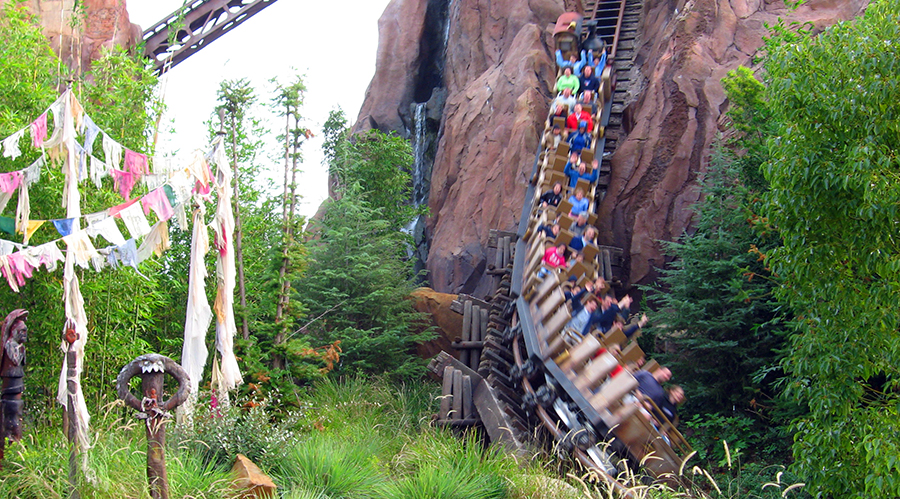Six Things You May Not Know About Expedition Everest

1. A New Disney Mountain
When Disney’s Animal Kingdom opened on April 22, 1998, the park promised to immerse Guests into a lush and authentic wilderness that represented the wonder and beauty of nature found throughout the world. The only attraction that could be classified as a thrill ride on that day was Countdown to Extinction (later renamed DINOSAUR), and while Kali River Rapids would open a few years later, Guests were still clamoring for a true headliner attraction to open at Disney’s newest park. Fortunately, they wouldn’t have to wait long, for plans had always been underway to bring a roller coaster thrill ride to the Animal Kingdom. In true Disney fashion though, this would be a roller coaster the likes of which had never been seen. In fact, one of the early concepts for the new attraction was a dragon-themed roller coaster that would have served as the anchor attraction for the park’s proposed BeastlyKingdom section.
2. But Which Mountain?
In the end, the team of Imagineers, led by Joe Rohde, came back to a concept that had proved immensely popular with Guests over the years: the mountain. Over in Disneyland, the Matterhorn was enjoying a renewal in popularity due to the inclusion of the Abominable Snowman in 1978, and it made sense for his Far Eastern cousin, the Yeti, to find a home here at the Animal Kingdom. Since the Yeti was said to prowl the Himalayas, Mount Everest seemed like the logical home for the park’s newest attraction. But even so, there was still much debate over that final choice. For one thing, Rohde didn’t think that Mount Everest was distinctive enough in appearance, especially when compared to the Matterhorn of Disneyland or Japan’s Mt. Fuji, one of several inspirations for the design of Space Mountain. The problem was solved in a uniquely Imagineer-esque way: Mount Everest would indeed appear in the attraction, but only as part of the mountain range that would include the attraction’s true mountain…but we’ll get to that a little later.
3. Making a Mountain Out of a Molehill
As the team of Imagineers started to design the look of the mountain itself, they started by making several small paper models based on a series of sketches by Chris Turner and his team of designers. These paper models were transformed into a 1/8th-inch scale clay model, and eventually a foam model. The design was revamped several times, and all in all went through 24 iterations before the final look was achieved. At this point, the model was six feet tall, and from there it was digitized into a computer. This process allowed the team to virtually program the ride itself before a single shovel was lifted, and it also allowed for the precise fabrication of the tons of rebar that would form the framework for the actual mountain. Utilizing the latest technology allowed the design process to take only 18 months, compared to the typical three to four years that would have been required using
traditional methods.
4. It’s All in the Details
This painstaking attention to detail wasn’t just reserved for the mountain itself; the same care went into the creation of the surrounding village. The architecture of the buildings was largely based on the Kali Gandaki region of the Annapurna Conservancy area of the Himalayas. Two methods of construction native to the region were used to create the show buildings. One method was “Dry-laid Stone,” used in the Tea House, and the other was the “Rammed Earth” method, in which moistened dirt is placed in a four-inch-high framed box and pounded with mallets until the material is as hard as concrete. Over 2,000 handcrafted items were brought in for use as architectural ornamentation, props, and cabinetry. Many of these items were actually made by native Newari wood-carvers from Nepal. Tibetan monks were consulted in regards to the earth-based pigments used to color the attraction’s sets.
5. Twisting Tracks
Construction of the new attraction began in March 2003 and would be comprised of three separate structures: the mountain itself, the actual roller coaster, and the Audio-Animatronic Yeti. The mountain and the track presented two opposing challenges. The tracks of the roller coaster needed to be flexible enough to allow for the high speeds and turns of the train, while the mountain needed to be absolutely inflexible since it was covered with layers and layers of the carved plaster that formed the rocky exterior. Great care was taken to ensure that the two structures never got closer than six inches to each other…no small task! 5,000 tons of structural steel went into the ride and structural systems.
6. How to Build a Mountain
The exterior of the mountain was actually an outer shell of sculpted plaster that was put together like a giant puzzle. To accomplish this Herculean task, Imagineers came up with a solution that they called the “chip method.” Using the digitized model as a starting point, the Imagineers were able to break this down into 3,307 individual modules, or “chips,” each one measuring approximately six square feet. Each chip was assigned a specific place on the mountain’s exterior, and the whole thing was assembled like a giant jigsaw puzzle. 27,000 pieces of computer-bent pieces of rebar went into the fabrication of the chips, and, all told, the chips added up to 218,00 square-feet of rockwork. Imagineers then used nearly 32,000 bags of cement to sculpt the individual rocks and peaks, using aluminum foil to mold the wet concrete into the exact shapes they wanted. They then finished off the exterior with more than 2,000 gallons of paint.

